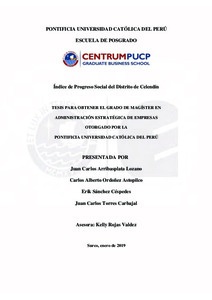| dc.contributor.advisor | Rojas Valdez, Kelly | |
| dc.contributor.author | Arribasplata Lozano, Juan Carlos | |
| dc.contributor.author | Ordoñez Astopilco, Carlos Alberto | |
| dc.contributor.author | Sánchez Céspedes, Erik | |
| dc.contributor.author | Torres Carbajal, Juan Carlos | |
| dc.date.accessioned | 2019-03-25T21:54:16Z | |
| dc.date.available | 2019-03-25T21:54:16Z | |
| dc.date.created | 2019-01 | |
| dc.date.issued | 2019-03-25 | |
| dc.identifier.uri | http://hdl.handle.net/20.500.12404/13819 | |
| dc.description.abstract | El interés por encontrar una herramienta que sea capaz de medir el nivel de progreso
de las sociedades y que a su vez permita comparaciones entre las mismas no es una
preocupación reciente. En ese sentido los esfuerzos desplegados al respecto a partir de
diversos enfoques han sido muy diversos. En la década de 1930 Kuznets presentó al Producto
Bruto Interno (PBI) convirtiéndose en el índice más empleado para medir la capacidad de
producción de una sociedad. Pero no es posible asociar el crecimiento económico per se con
el desarrollo y bienestar de una sociedad. A partir de la creación del Sistema de las Naciones
Unidas se han creado índices que permitan medir el desarrollo en función del bienestar social,
como el Índice de Desarrollo Humano (IDH), Índice de Oportunidades Humanas (OIH). En
ese sentido se presentó el Índice de Progreso Social (IPS) como una herramienta capaz de
medir el bienestar de las personas y sociedades con un enfoque integrador y holístico.
La presente investigación tiene un enfoque cuantitativo con alcance descriptivo y de
tipo no experimental, con el objetivo de medir el IPS del distrito de Celendín, para lo cual se
recabó información relevante sobre las actuales condiciones de vida de los pobladores. Para
la obtención de datos se utilizó fuentes primarias y secundarias. La fuente primaria fue
obtenida de la encuesta aplicada a una muestra de 385 hogares, la encuesta consta de 58
preguntas dirigidas a obtener información de los 12 componentes del IPS.
La recolección de datos realizada en el distrito de Celendín arrojó en un IPS de 48.58
ubicándolo en el rango bajo del Nivel de Progreso Social, con un nivel similar al de la región
Cajamarca. Las principales brechas identificadas en la presente investigación se encuentran
en la dimensión Necesidades Humanas Básicas con un valor de 43.19; igualmente se
encuentra una brecha crítica en la dimensión Oportunidades, con un valor de 50.79, ambos
indicadores se encuentran debajo del promedio de la región y el país; y finalmente en el
componente Fundamentos de bienestar se puede encontrar un nivel bajo con 51.78 puntos. | es_ES |
| dc.description.abstract | The interest in finding a metric that is capable of measuring the level of progress of
societies and that in turn allows comparisons between them is not a recent concern. In that
sense, the efforts deployed in this regard from different approaches have been very diverse. In
the 1930s, Kuznets presented the Gross Domestic Product (GDP) as the index most used to
measure the production capacity of a society. But it is not possible to associate economic
growth per se with the development and welfare of a society. Since the creation of the United
Nations System, indices have been created to measure development in terms of social
welfare, such as the Human Development Index (HDI), Human Opportunity Index (OIH). In
this sense, the Social Progress Index (IPS) was presented as a tool capable of measuring the
welfare of people and societies with an integrating and holistic approach.
The present investigation has a quantitative approach with descriptive and nonexperimental
scope, with the objective of measuring the IPS of the Celendín district for
which relevant information was collected about the current living conditions of the
inhabitants. To obtain data, we use sources primary and secondary. The primary source was
obtained from the survey applied to a sample of 385 households, the survey consists of 58
questions aimed at obtaining information on the 12 components of the IPS.
The data collection carried out in the Celendín district yielded an IPS of 48.58 located
in the Low range, which placed it at a level similar to that of the Cajamarca region. The main
gaps identified in the present investigation are in the Human Needs dimension Basic with a
value of 43.19; we also find a critical gap in the Opportunities dimension, whose metric is
50.79, both indicators are below the average for the region and the country; and finally in the
component Fundamentals of well-being we found an indicator of 51.78. | es_ES |
| dc.language.iso | spa | es_ES |
| dc.publisher | Pontificia Universidad Católica del Perú | es_ES |
| dc.rights | info:eu-repo/semantics/openAccess | es_ES |
| dc.rights.uri | http://creativecommons.org/licenses/by-nc-nd/2.5/pe/ | * |
| dc.subject | Indicadores sociales--Perú--Celendín (Cajamarca : Provincia) | es_ES |
| dc.subject | Indicadores económicos--Perú--Celendín (Cajamarca : Provincia) | es_ES |
| dc.subject | Investigación cuantitativa | es_ES |
| dc.title | Índice de progreso social del distrito de Celendín | es_ES |
| dc.type | info:eu-repo/semantics/masterThesis | es_ES |
| thesis.degree.name | Maestro en Administración Estratégica de Empresas | es_ES |
| thesis.degree.level | Maestría | es_ES |
| thesis.degree.grantor | Pontificia Universidad Católica del Perú. CENTRUM | es_ES |
| thesis.degree.discipline | Administración Estratégica de Empresas | es_ES |
| renati.advisor.dni | 41038596 | |
| renati.advisor.orcid | https://orcid.org/0000-0002-4866-1671 | es_ES |
| renati.author.dni | 42396839 | |
| renati.author.dni | 26732222 | |
| renati.author.dni | 26697853 | |
| renati.author.dni | 41668249 | |
| renati.discipline | 413307 | es_ES |
| renati.level | https://purl.org/pe-repo/renati/level#maestro | es_ES |
| renati.type | https://purl.org/pe-repo/renati/type#tesis | es_ES |
| dc.publisher.country | PE | es_ES |
| dc.subject.ocde | https://purl.org/pe-repo/ocde/ford#5.02.04 | es_ES |






